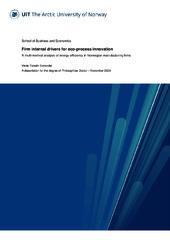Sammendrag
The high energy intensity of the manufacturing sector places it at the centre of all greenhouse gas emission abatement programmes. The thesis is thus motivated by the need to increase the environmental performance of the sector, and aims to explore the internal drivers in stimulating eco-process innovation in manufacturing firms. To this end, I use an explorative research design and explore the phenomenon from different theoretical, epistemological and methodological perspectives in three interdependent empirical studies. These studies are empirically informed by research on energy efficiency (EE). From the thesis results, I suggest a new typology of internal organisational drivers for eco-process innovation: environmental leadership, absorptive capacity, organisational structure and routines, and translation competence. Furthermore, the results point to the micro foundations of each driver and suggest an interrelation between the four drivers. This interrelation is discussed in a conceptual model. The thesis further contributes to the field by providing more knowledge on the impact and role of internal stakeholders at various organisational levels. By considering EE as an empirical phenomenon, the study is also of theoretical relevance to the EE literature. From my observations, the gap in the literature with regard to internal drivers is due to limited academic attention, ‘redundancy’ in theory development, and lack of theoretical framing and clarity in the definition of key concepts. Therefore, I suggest that, further research would benefit from a larger degree of problematisation of existing assumptions when designing research questions, build on alternative theoretical frameworks more actively, and are more explicit when defining key concepts. Thus, the further development of eco-innovation theory can extend our knowledge on the firm internal factors and mechanisms affecting the environmental transition of manufacturing firms. The thesis results also provide valuable insights for managers and policymakers as well as avenues for future research.
Har del(er)
Paper I: Solnørdal, M.T. & Foss, L. (2018). Closing the energy efficiency gap—a systematic review of empirical articles on drivers to energy efficiency in manufacturing firms. Energies, 11(3), 518. Also available in Munin at https://hdl.handle.net/10037/12679.
II: Solnørdal, M.T. & Thyholdt, S.B. (2019). Absorptive capacity and energy efficiency in manufacturing firms – An empirical analysis in Norway. Energy Policy, 132, 978-990. Also available in Munin at https://hdl.handle.net/10037/17127.
Paper III: Solnørdal, M.T. (2020). Translating a corporate environmental idea into energy management practices: A case study the implementation of energy management in a pharmaceutical company. (Manuscript). Now published as Solnørdal, M.T. & Nilsen, E.A. (2020). From Program to Practice: Translating Energy Management in a Manufacturing Firm. Sustainability, 12(23), 10084. Available in Munin at https://hdl.handle.net/10037/19982.


 English
English norsk
norsk
